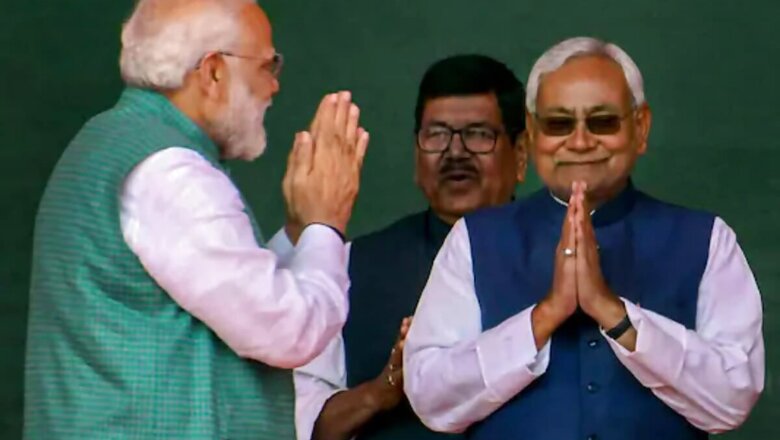
views
The groundbreaking ceremony at the site of the planned Ram temple in Ayodhya on August 5 created quite a stir. Congress leaders joined in the chorus. National Democratic Alliance (NDA) partners congratulated the Hindu brethren. So did Ram Vilas Paswan who has had strong moorings in social justice movements.
Bihar chief minister Nitish Kumar, however, spent the day in aerial survey of his state's flood-ravaged districts. His Twitter timeline reflects pictures of Janata Dal (United) leaders overseeing relief and rescue operations in Khagaria and elsewhere. Almost oblivious of the developments in Ayodhya.
Nitish Kumar’s ability to seek the Bharatiya Janata Party's support and yet maintain an arm's length from its ally has been the hallmark of his politics. One may even call it a mantra to survive in a polity which had all the ingredients to go bipolar between saffron brotherhood on one side and Lalu Prasad Yadav’s Rashtriya Janata Dal (RJD) on the other.
Bihar was the first state to pass a resolution against the proposed National Register of Citizens (NRC) last year, opening the floodgates for other states to follow suit. He supported demonetisation, yet did not join in the union council of ministers after being offered fewer than expected berths.
Kumar, with his hop, skip and jump, brings in a unique quality to the state's politics, as did the Indian socialists of yore who were equally compatible to an alliance with the Jana Sangh and the communists. Nitish Kumar can change sides to tilt the balance of power and votes from one end of the spectrum to the other. He displayed it successfully in the previous assembly polls. The upcoming elections this year pose a stiffer challenge and the JD(U) leaders seem to be preparing for the denouement well in advance.
Nitish Kumar's endeavours in Bihar for long have also been helped by the BJP’s inability to develop strong local leadership. The current party dispensation in Delhi wants to change all this. The promotion of Sanjay Jaiswal who comes from the same caste group as Sushil Modi is a testimony to that. Nityanand Rai and Giriraj Singh are also seen as strong proponents, bringing the BJP out of the shadows of the JD(U).
Under Atal Bihari Vajpayee and Lal Krishna Advani, the BJP had an unwritten agreement with regional allies. The party would aim to rule at the Centre while friendly partners would lead the government in states. That equation has changed since 2014. The party is not dependent on allies at the Centre. In states, its ambitious and aggressive leadership is seeking a larger share and supremacy.
In Maharashtra, the Shiv Sena was relegated to junior partner when Uddhav Thackray decided to seek greener pastures. In Punjab, the Shiromani Akali Dal (SAD) has had its moments of discomfort with the BJP. In Bihar, Nitish Kumar displayed his ability to damage the BJP by walking away with his vote share from the NDA alliance to help Lalu return to power.
The BJP’s rapprochement with the JD(U) was also expedited to deny a non-Congress leader from the Hindu heartland to rally around forces for the 2019 Lok Sabha polls.
In the upcoming assembly elections in Bihar, the equations and stakes have altered. The contest will be both within and outside the ruling NDA. Within the NDA during seat-sharing talks, because he who contests more seats has a higher probability of winning more, and to emerge as the single-largest party. Thus, the formula to accommodate smaller NDA allies from the quota earmarked for the JD(U) and BJP is the first hurdle in this steeple chase.
The 2015 election in the state threw up an assembly where any two parties of the three key players, JD(U), RJD and BJP, could come together to form the government. The JD(U) and RJD had a pre-poll alliance, so Nitish Kumar was sworn in as the chief minister. A couple of years later he decided to join hands with the BJP and remained at the helm.
Lalu conceded chief ministership to Nitish despite the RJD emerging as the single-largest party. The two parties parted ways because the one with more MLAs in the assembly wanted to dominate, or at least create an impression of being in control.
Would Nitish Kumar be comfortable leading an NDA alliance where the BJP has more MLAs than the JD(U)? With Lalu, he clearly wasn’t.
Which is why this election in Bihar is so much about the race to emerge as the single-largest party in the alliance and the state assembly.
















Comments
0 comment